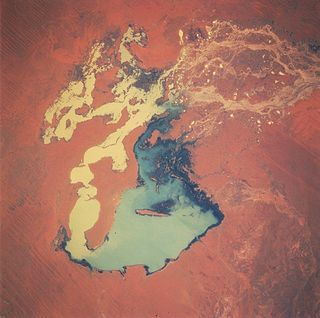
The Canning Stock Route is a track that runs from Halls Creek in the Kimberley region of Western Australia to Wiluna in the mid-west region. With a total distance of around 1,850 km (1,150 mi) it is claimed to be the longest historic stock route in the world.
Gija, also spelt Gidja and Kija, alternatively known as the Lungga, refers to Aboriginal Australians from the East Kimberley area of Western Australia, about 200 km south of Kununurra. In the late 19th century pastoralists were fiercely resisted by Gija people, many of whom now live around localities such as Halls Creek and Warmun.
The Tjurabalan (Jura-palan) is a nomadic desert tribe from the edge of the Tanami Desert near Sturt Creek and The Paraku Lake system, Lake Gregory in the Kimberley region of Western Australia.

Lake Gregory, or Paraku in the Walmajarri language, is a permanent brackish lake located in the Kimberley region of Western Australia, situated between the Great Sandy Desert and the Tanami Desert. Following monsoonal rains it may hold fresh water, but becomes more saline after a number of dry years.
The Djargurd Wurrong are Aboriginal Australian people of the Western district of the State of Victoria, and traditionally occupied the territory between Mount Emu Creek and Lake Corangamite.

The Gadubanud (Katubanut), also known as the Pallidurgbarran, Yarro waetch or Cape Otway tribe (Tindale), are an Aboriginal Australian people of the state of Victoria. Their territory encompasses the rainforest plateau and rugged coastline of Cape Otway. Their numbers declined rapidly following the onset of European colonisation, and little is known of them. However, some may have found refuge at the Wesleyan mission station at Birregurra, and later the Framlingham mission station, and some people still trace their descent from them.

Moola Bulla Station is a pastoral lease that operates as a cattle station in the Kimberley region of Western Australia. It is approximately 20 kilometres (12 mi) west of Halls Creek and 150 kilometres (93 mi) south of Warmun, and occupies an area of 6,600 square kilometres (2,548 sq mi). It bisects the watershed of the Fitzroy River and Ord Rivers.
The Yapurarra or Jaburara, also rendered Yaburara, are an Aboriginal Australian people whose traditional lands are in the Pilbara region of Western Australia and the Dampier Archipelago.
The Mangarla, or Mangala, are an Aboriginal Australian people of Western Australia. The Mangarla people traditionally lived in the north-western area of the Great Sandy Desert, west of the Karajarri people, east of the Walmajarri, with the Juwaliny and Yulparija to the south. Many Mangarla people now live in Jarlmadangah and Bidyadanga.

Billiluna Station is a pastoral lease that operates as a cattle station in Western Australia.
The Barindji, also written Parrintyi, are an indigenous Australian people of the state of New South Wales. They are to be distinguished from the Paaruntyi, who spoke a similar language but whom they called the spitting people.
The Gooniyandi, also known as the Konejandi, are an Aboriginal Australian people in the Kimberley region of Western Australia.
The Bilinarra, also spelt Bilingara and Bilinara, are an Aboriginal Australian people of the Northern Territory.
The Kwiambal are an Aboriginal Australian people of New South Wales.
The Walmadjari (Walmajarri) people, also known as Tjiwaling and Wanaseka, are an Aboriginal Australian people of the Kimberley region of Western Australia.
The Malngin are an Aboriginal Australian people of the Kimberley region of Western Australia. The Malngin language was a dialect of Gurindj.
The Gudanji, otherwise known as the Kotandji or Ngandji, are an indigenous Australian people of the Northern Territory.
The Wambaya people, also spelt Umbaia, Wombaia and other variants, are an Aboriginal Australian people of the southern Barkly Tableland of the Northern Territory. Their language is the Wambaya language. Their traditional lands have now been taken over by large cattle stations.
The Mudburra, also spelt Mudbara and other variants, are an Aboriginal Australian people of the Northern Territory.